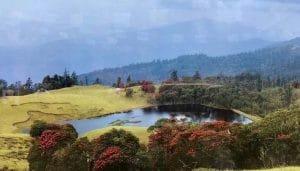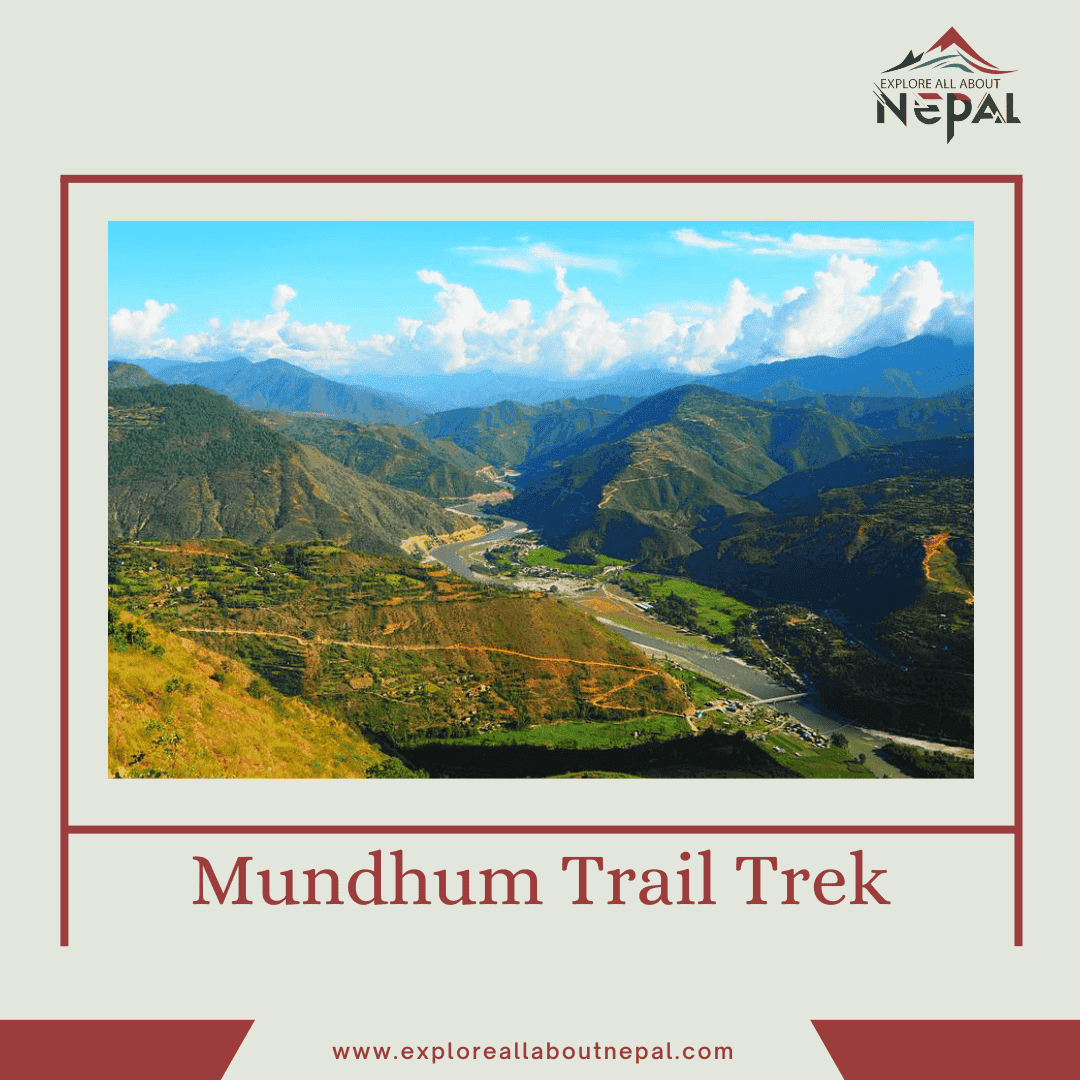Mundhum Trail Trek is an emerging trekking route that offers a unique blend of cultural exploration and natural beauty. This off-the-beaten-path trek takes travelers through the ancestral lands of the Kirati people, allowing them to experience rich indigenous traditions, untouched landscapes, and panoramic views of the Himalayas. If you’re looking for an authentic and less crowded trekking experience, the Mundhum Trail Trek is a perfect choice.

Location and Overview
The Mundhum Trail is situated in Khotang and Bhojpur districts of Nepal, spanning through lush forests, terraced fields, and high-altitude ridges. The trail is deeply rooted in Kirati mythology, and its name, “Mundhum,” refers to the ancient scriptures of the Kirati people. The trek provides a 360-degree view of the Himalayan range, including Mount Everest, Kanchenjunga, and Makalu.
Key Attractions of Mundhum Trail Trek
- Cultural Heritage – The trail passes through traditional Rai and Limbu villages, offering insights into their centuries-old customs, rituals, and folk music.
- Scenic Views – Spectacular panoramic views of Everest, Makalu, Lhotse, and Kanchenjunga make this trek a paradise for nature lovers.
- Off-the-Beaten-Path Experience – Unlike the crowded Annapurna or Everest trails, the Mundhum Trek offers a serene and peaceful trekking experience.
- Biodiversity – The region is home to rhododendron forests, rare orchids, Himalayan wildlife, and sacred lakes.
- Sacred Sites – Visit the religious sites of Salpa Pokhari and Hans Pokhari, revered by the local community.
Best Time to Trek the Mundhum Trail
- Spring (March-May) – Best for lush greenery, blooming rhododendrons, and mild weather.
- Autumn (September-November) – Offers clear skies, stunning mountain views, and comfortable temperatures.
- Winter (December-February) – Snow-covered landscapes but can be challenging due to extreme cold.
- Monsoon (June-August) – Heavy rainfall makes trekking difficult and increases the risk of landslides.
Trekking Itinerary
The trek can be completed in 7-10 days, depending on your pace and starting point. Below is a suggested 7-day itinerary:
Day 1: Kathmandu to Diktel (1,650m)
- Drive or fly to Diktel, the starting point of the trek.
- Explore local villages and prepare for the journey.
Day 2: Diktel to Chakhewa (2,300m)
- Trek through terraced fields and traditional Rai settlements.
- Enjoy views of rolling hills and dense forests.
Day 3: Chakhewa to Rawa Danda (3,100m)
- The trail gradually ascends through rhododendron forests.
- Overnight stay at Rawa Danda with breathtaking Himalayan views.
Day 4: Rawa Danda to Salpa Pokhari (3,800m)
- Visit Salpa Pokhari, a sacred lake associated with Kirati myths.
- Camping or homestay near the lake.
Day 5: Salpa Pokhari to Silichung Peak (4,153m) and Back to Hyakule
- Hike to Silichung Peak, the highest point of the trek.
- Descend to Hyakule village for an overnight stay.
Day 6: Hyakule to Bhojpur (1,600m)
- The trail descends through pine forests and farmlands.
- Overnight stay in Bhojpur, a historic town.
Day 7: Bhojpur to Kathmandu
- Fly or drive back to Kathmandu.
Trekking Budget and Costs
The estimated cost for the Mundhum Trail Trek ranges from $400 to $700 per person, depending on the trekking style (independent or guided). Below is a breakdown:
- Transport (Kathmandu to Diktel & Bhojpur to Kathmandu): $30 – $100 (bus or flight)
- Permits: $20 – $40 (local entry fees)
- Accommodation: $5 – $15 per night (homestays and teahouses)
- Food: $5 – $10 per meal ($100 – $150 for the trek)
- Guide & Porter: $20 – $30 per day (optional but recommended)
- Miscellaneous (gear, snacks, tips): $50 – $100
How to Get to the Mundhum Trail
- By Flight: Take a domestic flight from Kathmandu to Tumlingtar or Bhojpur, followed by a short drive to Diktel.
- By Bus: Daily buses from Kathmandu to Diktel take about 8-10 hours.
- Private Jeep: A private jeep is available for a comfortable but costly alternative.
Permits and Regulations
- No special trekking permits are required, but an entry permit for Makalu Barun National Park may be needed if you extend your trek.
- Always carry a copy of your passport and TIMS card (Trekking Information Management System).
Accommodation and Food
- Homestays and basic teahouses are available along the route.
- Meals include local Nepali dal-bhat (rice and lentils), noodles, Tibetan bread, and organic vegetables.
- Bring snacks and water purification tablets as supplies are limited in remote areas.
Essential Travel Tips
- Acclimatization: The trek reaches 4,153m, so take it slow and drink plenty of water.
- Packing List: Bring warm clothes, sturdy trekking boots, a sleeping bag, and rain gear.
- Local Etiquette: Respect local customs, ask before taking photos, and avoid littering.
- Connectivity: Limited phone network; consider carrying a local SIM (NCELL or NTC).
- Emergency Contacts: Carry emergency numbers and basic first-aid.
Why Choose the Mundhum Trail Trek?
- Less Crowded: Ideal for those seeking peace and solitude.
- Rich in Culture: One of the few treks that deeply explore Kirati traditions.
- Moderate Difficulty: Suitable for beginners with basic fitness.
- Diverse Landscapes: From green hills to high-altitude lakes and snow-capped peaks.
Highlights
Mundhum Trail Trek is an emerging trekking route in eastern Nepal.
The Mundhum Trail Trek offers breathtaking views of Everest, Makalu, and Kanchenjunga.
Trekkers on the Mundhum Trail Trek pass through traditional Rai and Limbu villages.
The Mundhum Trail Trek is named after the ancient Kirati spiritual text, “Mundhum.”
The Mundhum Trail Trek takes adventurers through lush rhododendron forests and sacred lakes.
Homestays along the Mundhum Trail Trek allow travelers to experience authentic Kirati culture.
The Mundhum Trail Trek is less crowded than popular treks like Everest Base Camp and Annapurna.
The highest point of the Mundhum Trail Trek is Silichung Peak (4,153m).
Trekkers on the Mundhum Trail Trek visit the sacred Salpa Pokhari Lake, an important pilgrimage site.
The Mundhum Trail Trek is best visited in spring and autumn for clear skies and scenic beauty.
The cost of the Mundhum Trail Trek is lower than many commercial treks in Nepal.
The Mundhum Trail Trek provides opportunities to explore unexplored landscapes and indigenous traditions.
The Mundhum Trail Trek starts from Diktel and can be completed in 7-10 days.
The Mundhum Trail Trek offers a unique blend of adventure, nature, and cultural heritage.
If you’re looking for an off-the-beaten-path experience, the Mundhum Trail Trek is a perfect choice!
Conclusion
The Mundhum Trail Trek is an extraordinary journey that blends nature, spirituality, and adventure in one of Nepal’s least-explored regions. Whether you are an avid trekker or a cultural enthusiast, this trek offers a rewarding and authentic Himalayan experience. With stunning mountain views, fascinating ethnic heritage, and tranquil trails, the Mundhum Trek is truly a hidden gem worth discovering.
So, are you ready to explore the untouched beauty of the Mundhum Trail? Plan your trek today and experience the adventure of a lifetime!


